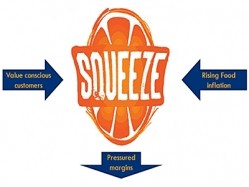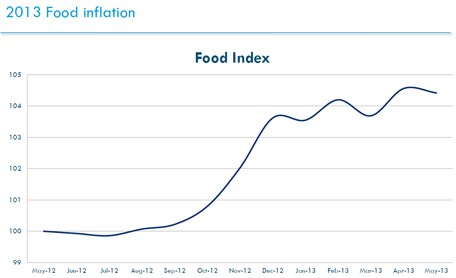Operators 'must optimise food distribution and sourcing' as food inflation takes its toll

That’s the message from supply chain consultants Prestige Purchasing, which claims that the food inflation surge that so many suppliers and foodservice consultants have fearedcould be just around the corner.
“Just as this issue will affect households, the same impact will be felt by the catering and hospitality trade,” said Prestige’s chief executive David Read. “Caterers need to take steps to mitigate the cost impact of this pressure on agricultural land availability.
“This may well lead to a further significant spike in food inflation, which as we predicted has continued to rise in 2013 and will do beyond.”
2013 trendsIn its latest report, Prestige Purchasing highlighted a number of foods likely to be particularly impacted by inflation:
- Butter: Reduced milk supplies are having a knock-on effect, and being driven into other markets. As such, butter supplies are tighter and prices are continuing to climb
- Salmon: Poor weather has resulted in massive prices hikes – Norwegian salmon is up 63 per cent on average and Scottish salmon is up 45 per cent
- Olive Oil: World production is down by 26 per cent year-on-year. Price increases are expected to continue, with rice bran oil now being suggested as an alternative
The rate for fruit and vegetables, including potatoes, has also been pushed up by poor harvests in terms of yield and quality. This increase is also expected to grow next year and beyond as a number of factors continue to impact food prices. "Per-tonne production costs for agriculture are increasing significantly, due to low yields and a dramatic increase in feed costs," Read explained.
Prestige Purchasing believes these findings are part of a wider trend which has, across all categories of food and drink, seen the inflation rate leap. In the longer term, broader trends like climate change, population growth and the increasing sophistication of commodity markets will continue to adversely impact food and drink prices, it says.
“Smart catering and hospitality operators need to adapt to this new era of food inflation by optimizing distribution and sourcing, using tools like benchmarking and insight, and improving the way in which the whole value chain is delivered in their organisations,” added Read. “Only by doing this can operators ensure that they remain competitive in the difficult years ahead.”
Another method of combatting food inflation is to keep your menus simple. Earlier this year, chefs and restaurateurs were advised to look at streamlining processes within the kitchento help keep their business thriving while food prices continue to rise.












